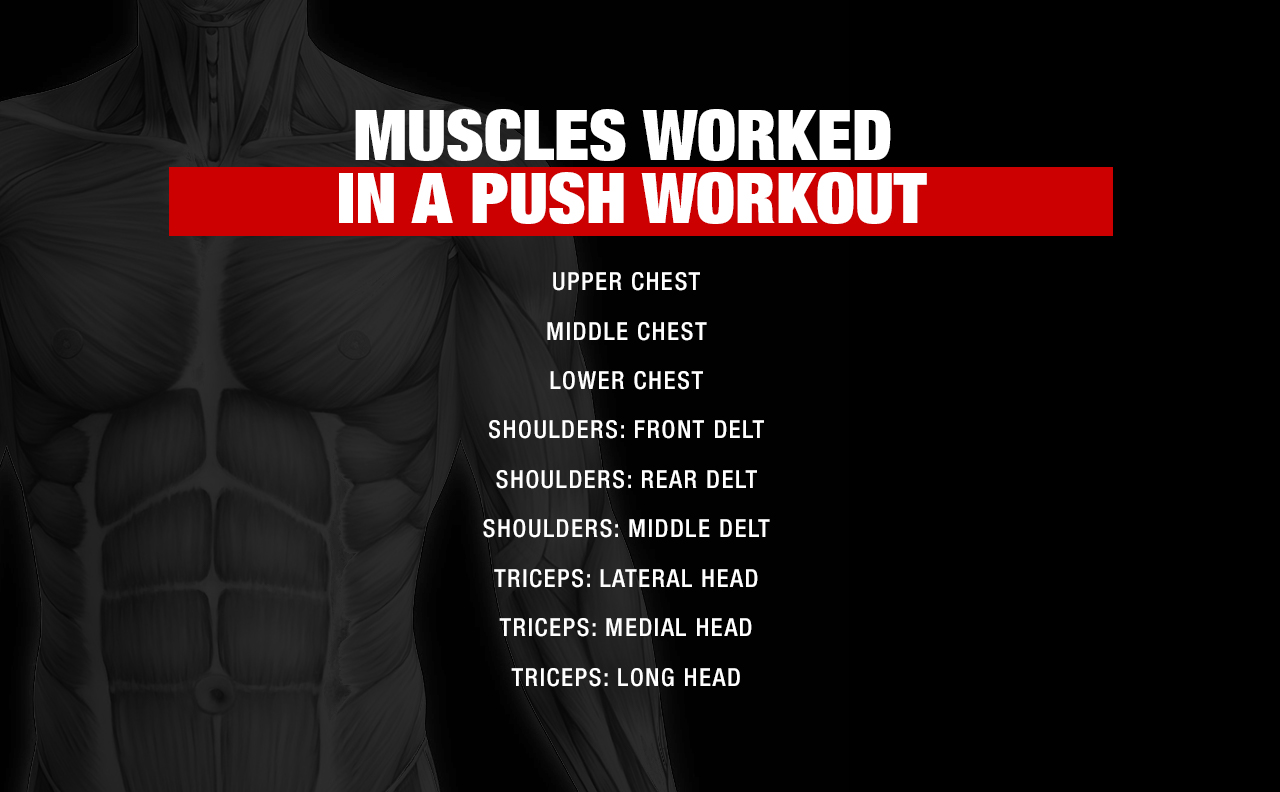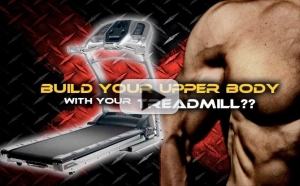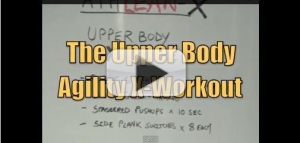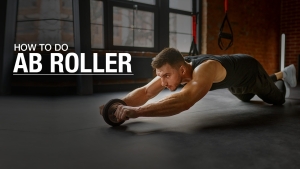
PUSH-PULL-LEGS SPLIT: PUSH WORKOUT
What are your training goals? Is it time to start packing on some muscle?
One question I am commonly asked is “What is the best type of workout for building muscle size?”
Well, there are a few different ways you can go about this, but we’re going to focus on the most effective and efficient workout split: a traditional Push, Pull, Legs (PPL) split workout for mass.
In this article, I’m going to cover the Push Workout routine that covers upper body exercises that work the push muscles.
I’ll also cover supersets, which is when you pair two similar or two opposing muscle group exercises together, performing them one after another.
For example, a superset would be an Incline Bench Press immediately followed by Push-Ups. Another example would be a Dumbbell Fly followed by a Lat Pulldown.
I’m making my bold selections for the best push day exercises because I believe this is one of the most effective workout routines to help you level up and build muscle.
I want to break it down for you step-by-step and show you not just the exercise selection and reps and sets per exercise for this workout routine, but why we’re choosing it so you can get the gains that you’re looking for.
WHAT MUSCLES DO PUSH WORKOUTS WORK?
Let’s start by understanding the anatomy of each of the upper body muscles that you’ll be targeting in the Push Workout: the chest muscles, shoulders, and triceps muscle.
Examples of effective push exercises include the flat bench press and body weight push-up.
Understanding which major muscles you’re focusing on will help you build a stronger mind-to-muscle connection in the major push muscle groups.
UPPER CHEST (CLAVICULAR HEAD PECTORALIS MAJOR)


MIDDLE CHEST (PECTORALIS MAJOR)


LOWER CHEST (PECTORALIS MAJOR)

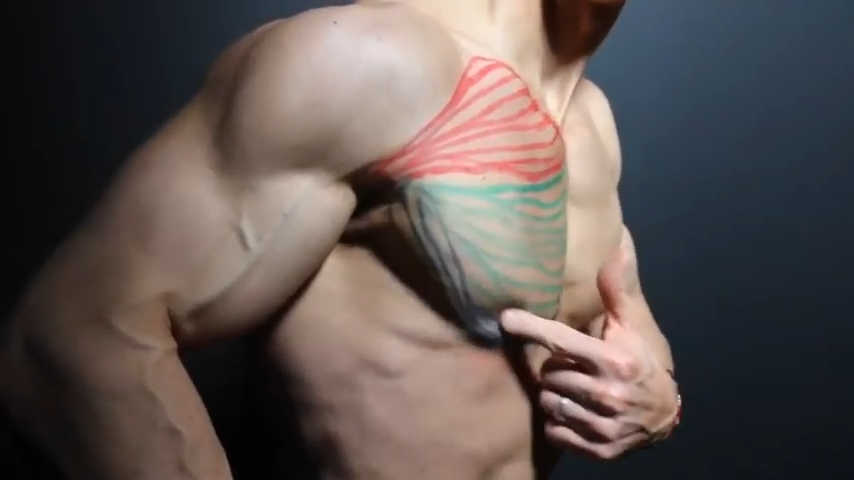
SHOULDERS: FRONT DELT

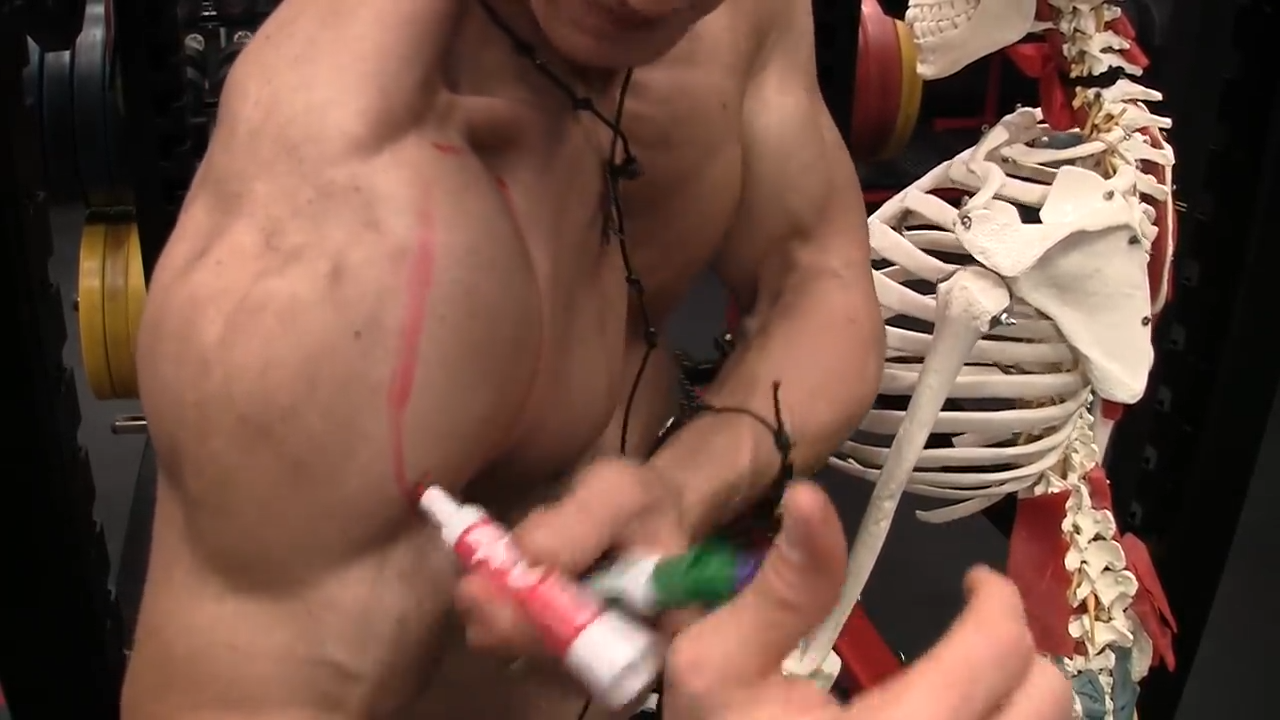
SHOULDERS: REAR DELT (POSTERIOR DELTOID)

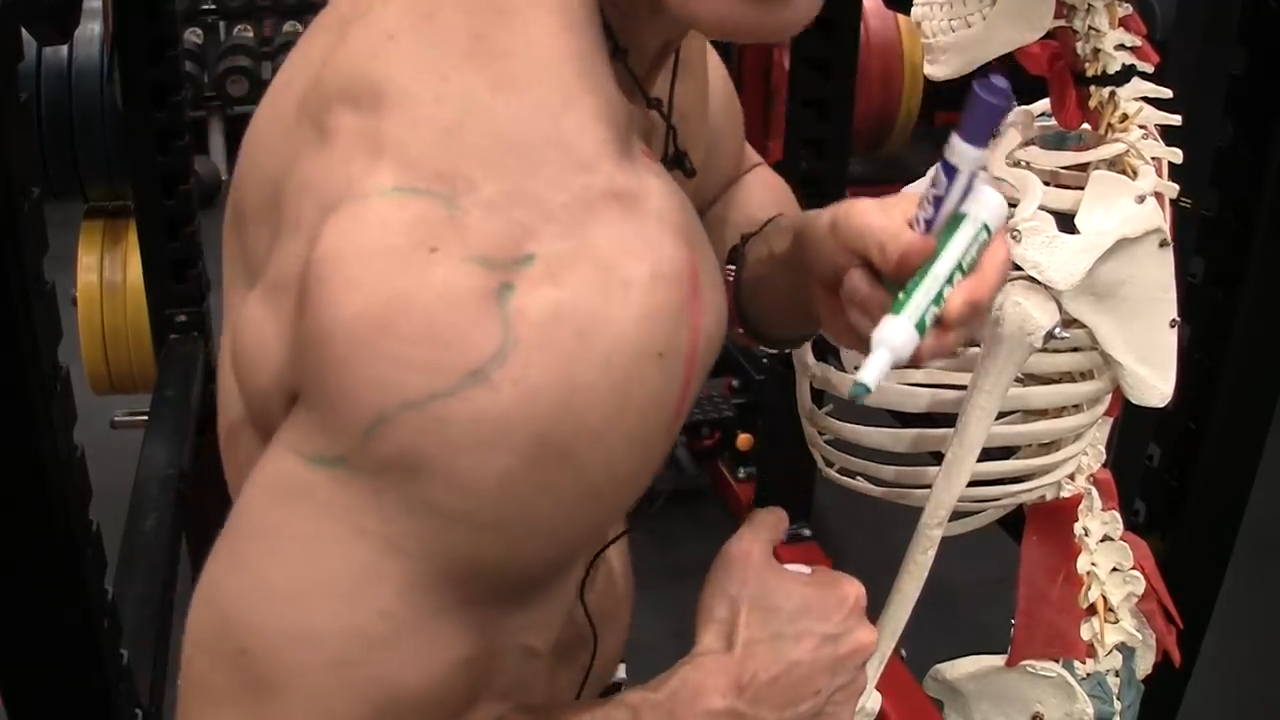
SHOULDERS: MIDDLE DELT (LATERAL DELTOID)

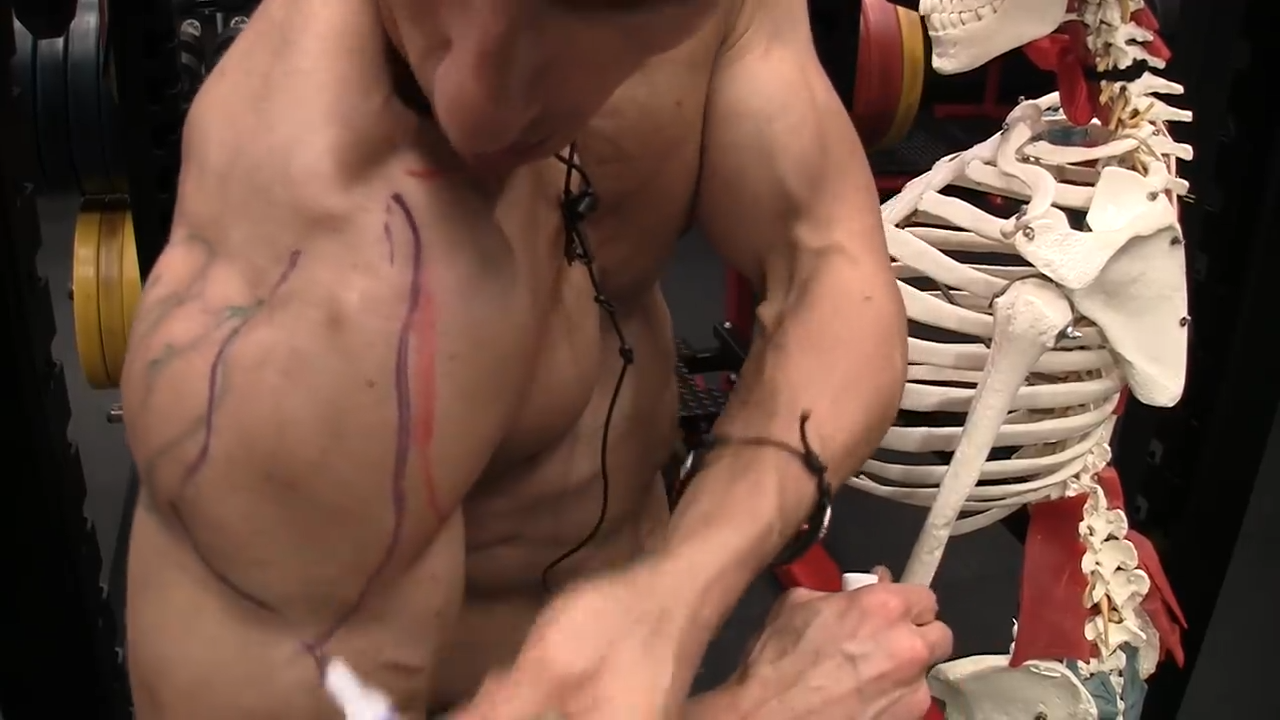
TRICEPS: LATERAL HEAD

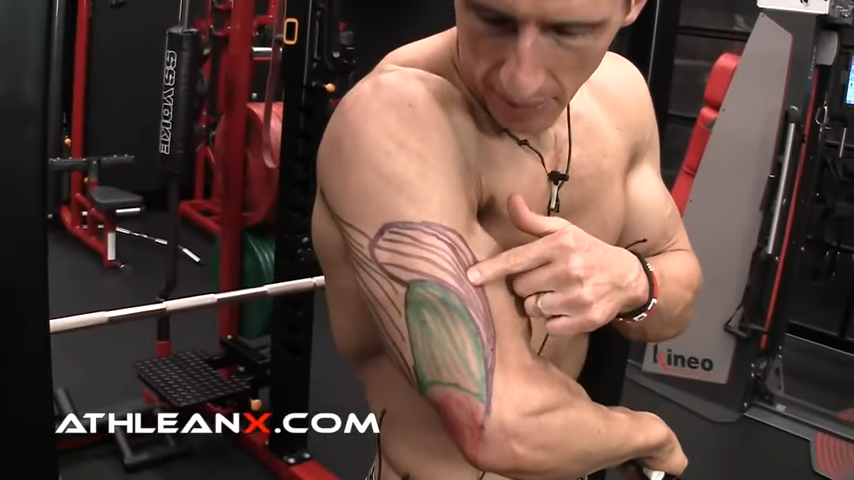
TRICEPS: MEDIAL HEAD


TRICEPS: LONG HEAD

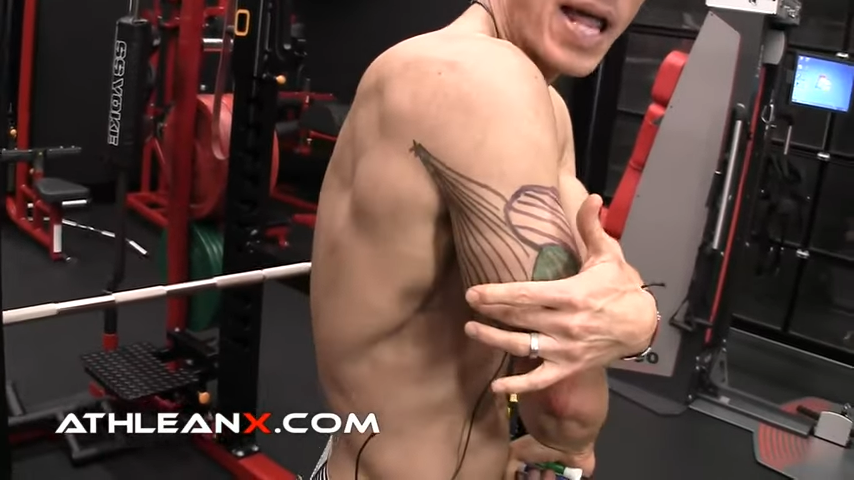
WHAT IS A PUSH-PULL-LEGS SPLIT?
Now a quick refresher for those that are unfamiliar with what a Push Workout is.
A Push Workout training plan is one part of a bigger workout program known as the PPL (Push Pull Legs Workout) split method of training.
During the Push Workout or Push Day, you’ll train your pushing muscles. Generally, this encompasses your triceps brachii, shoulders, and chest muscles.
And on Pull Day, you’re training the movement patterns in biceps and back. Keep in mind that there are a lot of back muscles and we’re accounting for those in that workout.
And, of course, you have your leg workouts on a specific workout day as well.
During the next several weeks, the way we’re going to break this down in this PPL split is by starting with a Pull Workout, and following it with a Push Workout, which is what I’m going to show you here, and then go into our leg exercises on Legs Day. You’ll be training six times per week.
Knowing how the workouts will proceed one after another, you have two options as far as how you’ll perform them from week to week.
SYNCHRONOUS SPLIT
Working six days consecutively in every weekly workout schedule is called a Synchronous Split. You repeat this cycle for six straight training days per week before taking a day of rest and then repeating it all over again.
ASYNCHRONOUS SPLIT
Or you can perform these three workouts and then put a rest day after the third workout, which gives you time between workouts. In this case you’d be training six days per week as well. After your rest day, you start these three days again, followed by another rest day. This is called an asynchronous split.
With an asynchronous split, you’re getting more rest days in between these workouts, which allows for better muscular recovery. But these rest days tend to be unpredictable, and some of you might not like that. But I do believe that the benefits of getting that extra off day for proper recovery are going to serve you well.
EXERCISES IN THE PUSH WORKOUT
I believe when we’re trying to accomplish something as big as creating muscle growth with this split, we need to have more upper body push exercises at our disposal.
Which brings us now to our Push Day workout routines.
In this excellent Push Workout plan, you’re getting two of them: Push One and Push Two.
And the reason for that is we’re going to select intense exercises that help to complement each other and provide you with a balanced physique. But these push day workout staples also stand alone with their own benefits.
PERFECT PUSH WORKOUT ONE
Push Workout One starts with a classic push exercise, and it is ideal for building strength in the chest muscle fibers, which is one of our main mechanisms of driving growth through overload by increasing weight over time.
I’m talking about the flat Barbell Bench Press, one of the most classic compound exercises for muscle hypertrophy.
BARBELL BENCH PRESS

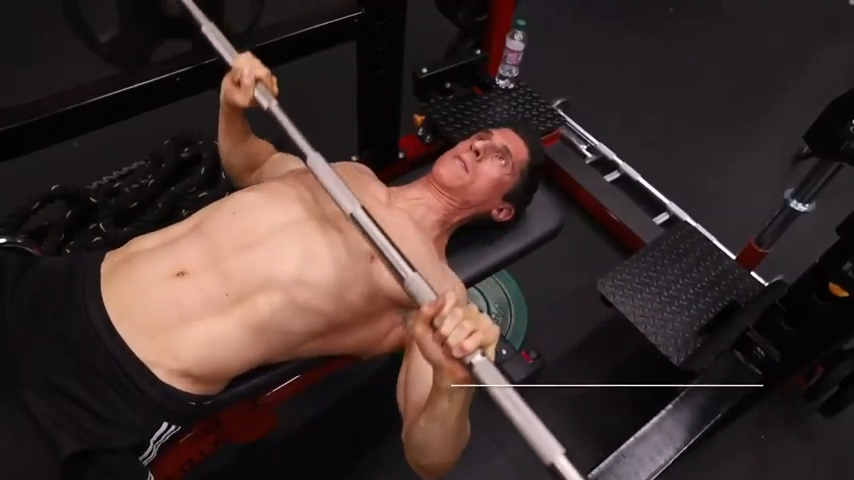
You’re going to perform this flat Barbell Bench Press motion as four sets of four to six repetitions at the bench press station, however be sure to leave one or two reps in the tank. Don’t take this heavy compound lift all the way to muscle failure.
With this classic barbell exercise, it’s important that as you start to fatigue, that you adjust the weight load accordingly to allow you to continue to fall within the four to six reps range. At the same time, don’t let your ego take the wheel here. Avoid injury by aiming for this rep range, and not your one-rep max. Maintain perfect form raising and lowering the bar with control, and keep core tight throughout the entire exercise and be sure to take rest intervals of 1-2 minutes of rest between sets. This is an excellent exercise for upper body strength and muscle hypertrophy.
HI-TO-LOW CROSSOVER
The next chest exercise is a classic cable machine exercise specifically designed to be a complementary exercise to the classic Bench Press and it’s the Hi-to-Low Crossover.

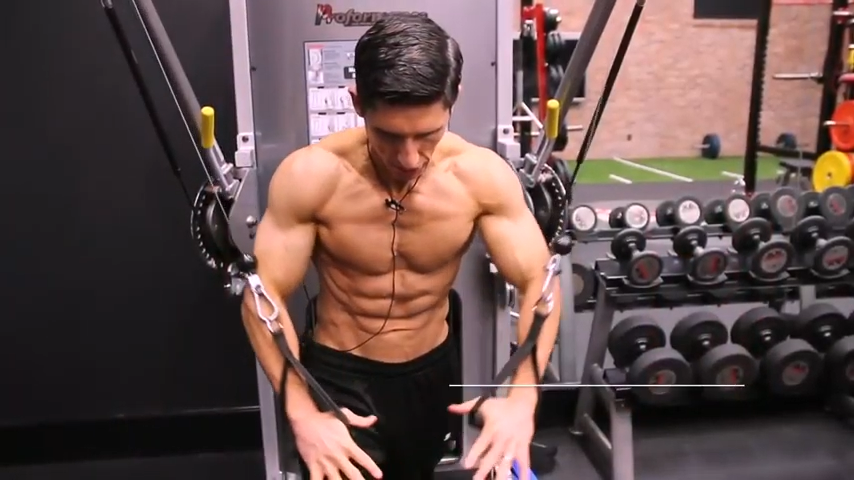
The reason why I like the crossover done with a cable pulley is it gives me the chance to do what the Barbell Bench Press doesn’t, which is to get the chest into a completely contracted state by getting the arm into the motion of being fully adducted across the body in a controlled motion. This offers a major benefit.
When we take the angle from high to low, we’re allowing ourselves to follow the fibers to hit more of the lower chest muscle fibers.
You might even feel this is a light core workout, especially in the upper core muscle.
But most importantly, it gives us the opportunity to get that full adduction range of motion of the hand across the chest, making it a great hypertrophy exercise. Perform three sets of 10 to 12 reps.
DUMBBELL OVERHEAD SHOULDER PRESS
And now I’m going to shift the focus a little bit to the shoulder muscles with the Dumbbell Overhead Shoulder Press.

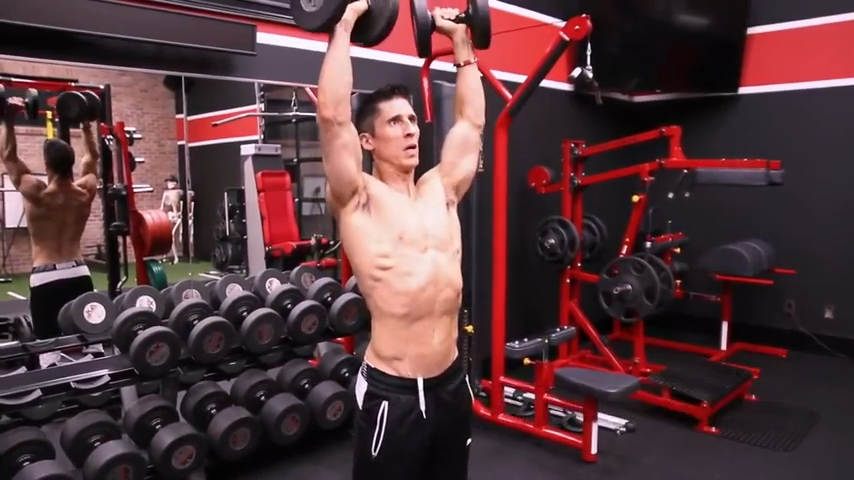
While I have the opportunity to try to do a Barbell Overhead Press, I believe that is better served as a functional strength building exercise and it’s going to get its own day in the best Push Workout – Part Two.
You’ll be doing the standing version of the overhead Shoulder Press for our vertical pressing exercise rather than the seated version because I don’t like the restrictions that come from pushing your scapula back into the bench during the seated version. This can disrupt normal mechanics of the shoulder joint.
For this shoulder exercise, use a pair of dumbbells. Starting position is with the dumbbell at shoulder height and press up above your head. Rather than having forearms vertical in these dumbbell shoulder presses, keep a slight bend in the elbows. Raise and lower the dumbbells back to the starting position with control. Perform four sets of 8 to 10 reps of the dumbbell press.
1 1/2 SIDE LATERAL RAISE
We then move on to the second shoulder exercise, following up very much the same way we did with the crossover. You’ll perform the 1 1/2 Side Lateral Raise.

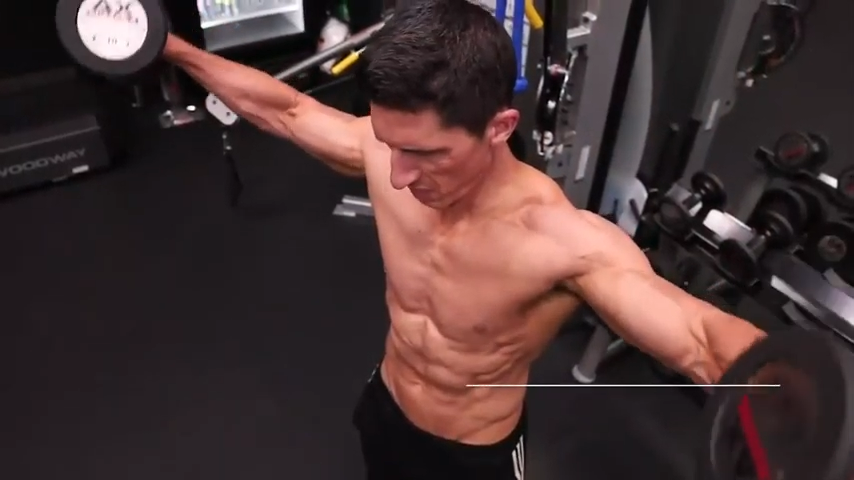
In trying to focus a little bit more for hypertrophy on that middle delt, the style of this essential movement increases the time that we’re under tension and helps build broad shoulder muscles.
Starting position is standing feet hip width apart and holding a pair of dumbbells (choose lighter weights) in each hand. Take the light weights up to the top just above shoulder level, come down halfway, and then go back up to the top again before fully lowering the weight.
Be sure to focus on good quality contractions, proper form and a stable core and perform three sets of 12 to 15 reps.
LYING TRICEP EXTENSION
Moving to the direct tricep portion of the workout, you’ll pair up a tricep muscles (pushing) exercise with a biceps (pulling) exercise. Why are we doing pull exercises on push day?
Because gives you the maximum benefit of some additional volume for the biceps on push day without interfering with what you’re trying to accomplish with your upper body push exercises.
Start with a big push exercise for the triceps muscle, the Lying Triceps Extension.

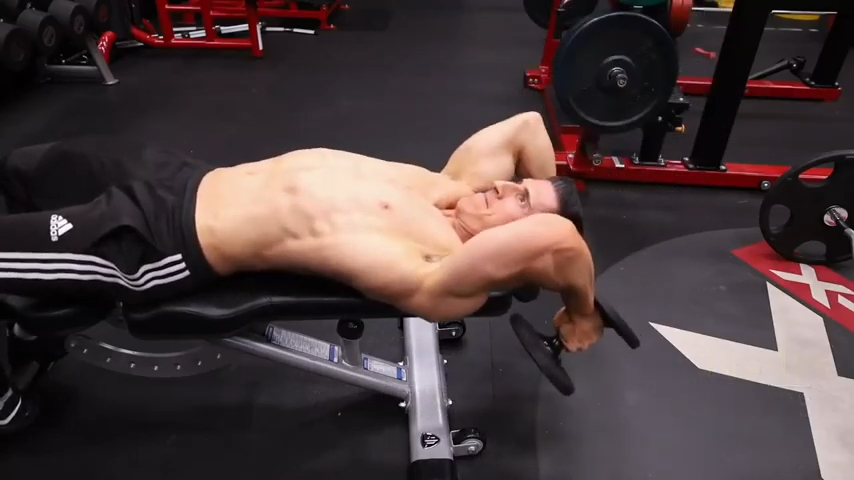
This triceps exercise hits the long muscle head primarily by getting a deep stretch in the bottom position.
Perform for three sets of 10 to 12 to muscle failure.
DUMBBELL WAITER’S CURL
Now, move right into your bicep curls movement: the Dumbbell Waiter’s Curl.

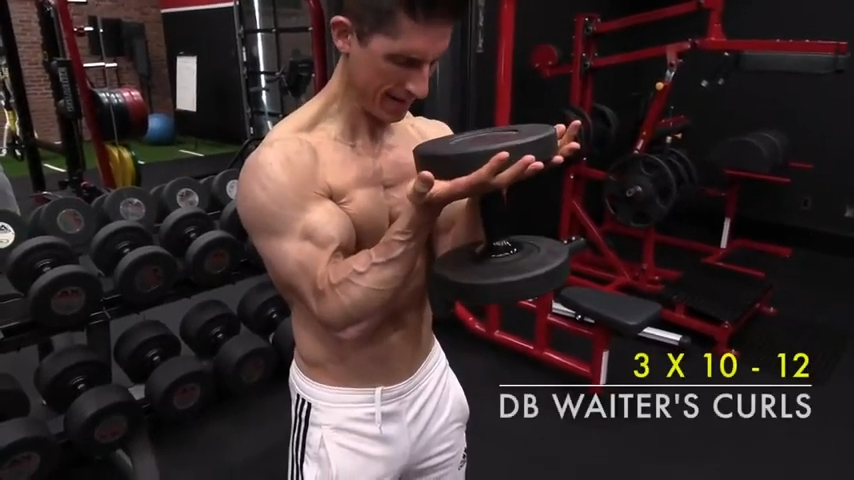
The Dumbbell Waiter’s Curl is also a long head exercise, but this time for the biceps. This variation on one of the most common pull exercises serves as a perfect complement to the triceps exercise, giving you a chance to get some additional volume. Use a pair of dumbbells and perform three sets of 10 to 12 reps.
ROTATOR CUFF MUSCLE EXTERNAL ROTATION
Before you call it a day, no ATHLEAN-X workout would be complete without making sure you pay a little bit of attention to bulletproofing your body. And you do that with the use of some corrective exercises.
You’ll be wrapping up the workout with the Rotator Cuff External Rotation which will help build the muscles surrounding the shoulder joint.


When you do a push routine, you’re internally rotating your muscles a lot. One of the key benefits to performing this rotator cuff exercise is that by simply doing some additional direct external rotation, you can correct this potential imbalance. The resistance band also provides constant tension throughout the exercise, ensuring you’re getting the most out of it.
Guys, simply grab a band and perform this all-important exercise to finish out this workout. Perform three sets of 15 to 20.
PERFECT PUSH WORKOUT TWO
That brings us to push workout number two, which again, is not just for the sake of doing another upper body workout routine – rather it’s meant to complement what we either did or did not do in the first push workout.
There are certain things I still want to accomplish here, and it starts right off the bat with a heavy load compound exercise, the Overhead Barbell Press.
OVERHEAD BARBELL PRESS
The Overhead Press will serve as the compound lift meant to increase our upper body strength and to drive hypertrophy through that increased strength gain.


Just like you did with the Bench Press, perform four sets of four to six reps of the barbell overhead press, leaving one or two reps in the tank for this lift. Adjust the weights accordingly to ensure that you stay in that rep range on all four sets. Again, pay attention to proper form and core stability with this heavy compound lift and take rest intervals of 1-2 minutes between sets.
DUMBBELL UNDERHAND BENCH PRESS
We follow that up by shifting our focus away from the shoulders to the chest again with a dumbbell form of bench pressing, the Dumbbell Underhand Bench Press.

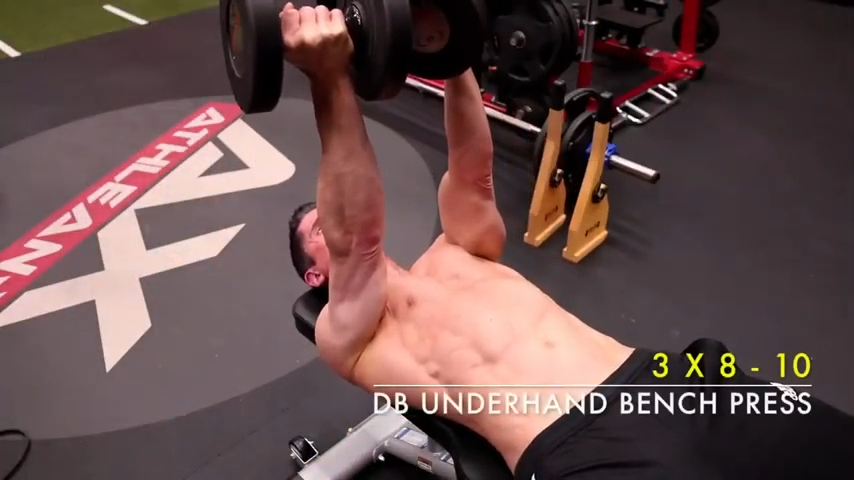
I love this dumbbell bench press because it allows you to work the upper chest even though we’re in a flat bench position using a pair of dumbbells.
It saves our shoulders and front delts specifically from the training overload and potential injury that would come if we were trying to do this as an overhand grip Incline Dumbbell Bench Press.
So, we get the benefits of upper chest training without having to put ourselves in a position mechanically that might overtax your shoulders.
ABDUCTION ROW
Just like we did in the first push workout routine, we’re going to try to hit the middle delt more specifically.
As a matter of fact, we’re also going to get the benefit of getting the rear deltoid muscles (posterior delts) involved. But we’re going to do it by driving with a posterior chain pull dominant movement.
That’s right, a pull-down movement push day.
And the reason we do this is if there’s any fatigue that has accumulated to this point, you’re going to have a chance to offset that with pull exercises rather than pushing more while still working the same muscles.
The Abduction Row is getting the shoulder into the necessary abduction to hit the middle and the rear deltoid muscles this time.

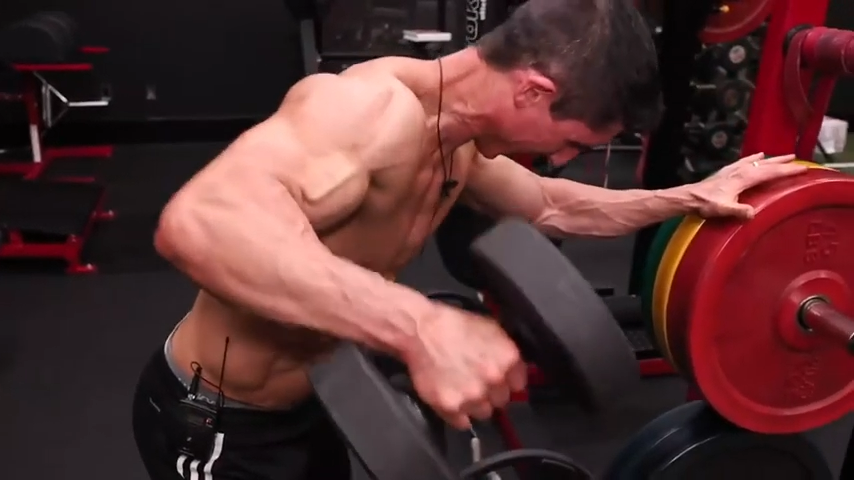
Starting position is standing with feet shoulder width apart and leaning forward slightly holding a single dumbbell. Drive into abduction by rowing the arm back and out, bringing the dumbbell up to about chest height, making sure to keep extra rotation at the shoulder.
But you’ll see and feel that this will light up the middle and rear delts very effectively allowing you to train it with heavier weight as well, in the 8 to 10 range, while still allowing you enough energy to continue to attack the rest of this push workout. Another benefit of this exercise is that working the delts unilaterally helps avoid muscle imbalances.
DUMBBELL FLOOR FLY
Which brings us to our fourth exercise, and we’re back to the chest with the Dumbbell Floor Fly.

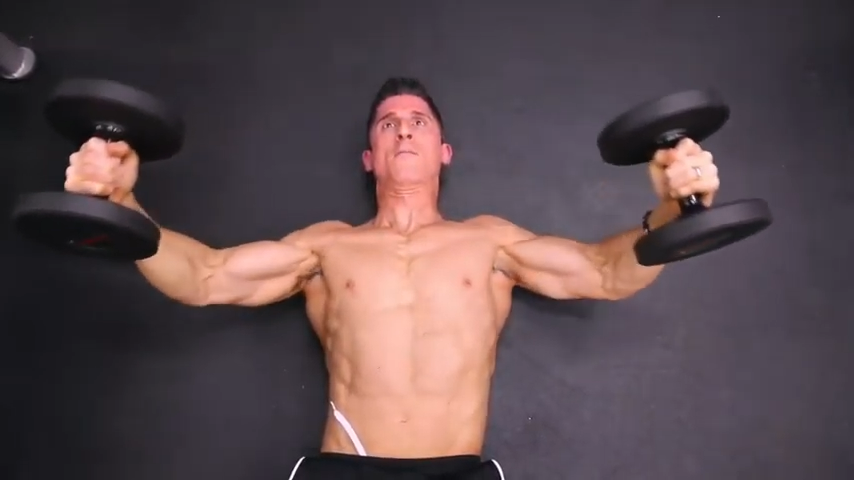
Now, you guys know how I feel about the unsupported version of chest flyes done on a flat bench. I feel like it compromises the health of your shoulder and increases the risk of injury where we don’t need to.
If we simply do these dumbbell flyes down on the floor, we get two additional benefits.
Number one, we have the safety net of the floor to make sure that we’re not over stretching the capsule of anterior shoulder.
And secondly, we have the opportunity to use heavy weights because we can take these up and we can even cheat them up to the top if we have to and lower them down.
What we’re really focused on here is getting that eccentric overload, which we know is another driver of hypertrophy.
Starting position is lying on the floor with a pair of dumbbells in each hand and elbows at about a 90 degree angle and feet flat on the ground. Perform flies, allowing the pair of dumbbells to touch at the top of the movement. We perform these dumbbell flyes for three sets of 10 to 12.
TRICEPS CLOSE GRIP BENCH PRESS
Which brings us to the direct triceps portion of this challenging workout, which is going to once again be followed by some additional bicep work for volume.
But this time we’re going to go a little bit heavier. We’re going with the Triceps Close Grip Bench Press.

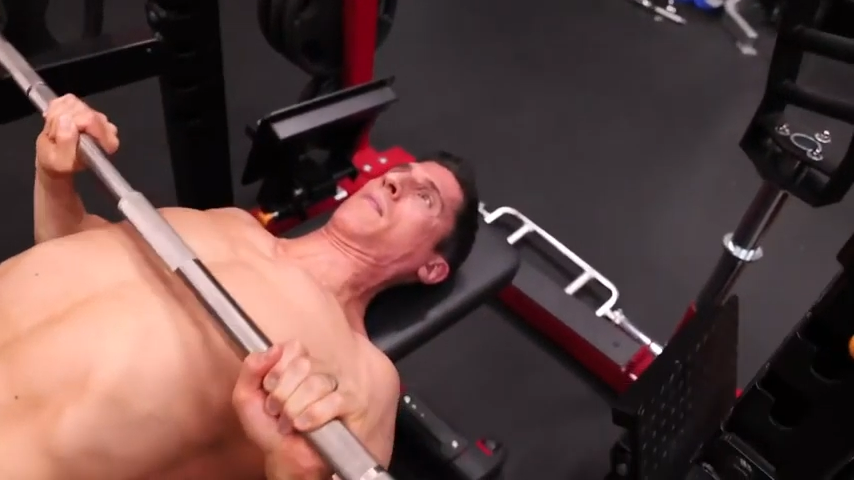
We select this close grip bench press variation as a complement to the tricep extensions we did, which was focused more on the long head.
Here, once again, now we’re using some additional weight to focus on the medial lateral heads.
Performing three sets of six to eight reps, you’ll add a strength-based movement that is more triceps focused to create additional gains in triceps strength.
DUMBBELL CURL OF CHOICE
And the exercise you’re going to pair that up with this time is simply a dumbbell curl of your choice using a pair of dumbbells in each hand.

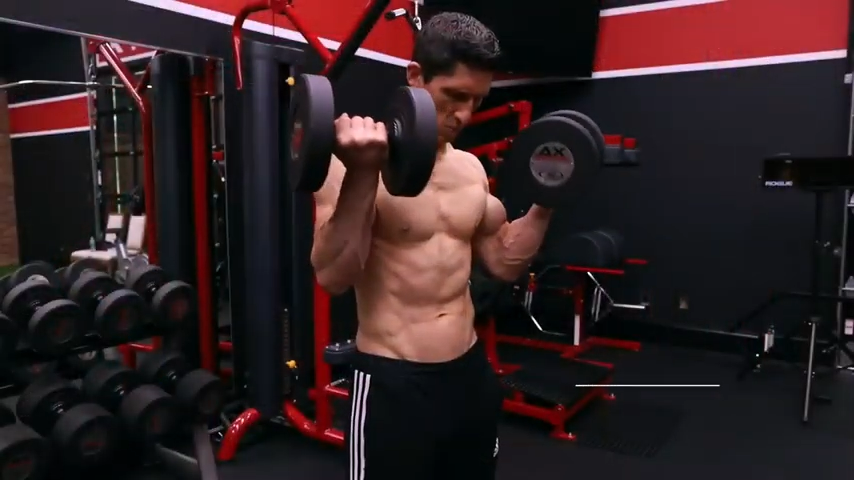
After all, curls are essentially curls, no matter how you perform them. Choose one of them, begin in the classic starting position, pair them as a superset, and perform them for three sets of 10 to 12 reps.
PUSHUP PLUS
And that brings us to that final spot once again. And I have an interesting bodyweight strength training exercise to end the second workout.
I want to work on some scapula control and some scapula strengthening, but I still want to get a little bit additional volume for the chest and that’s why we’re using the Pushup Plus.

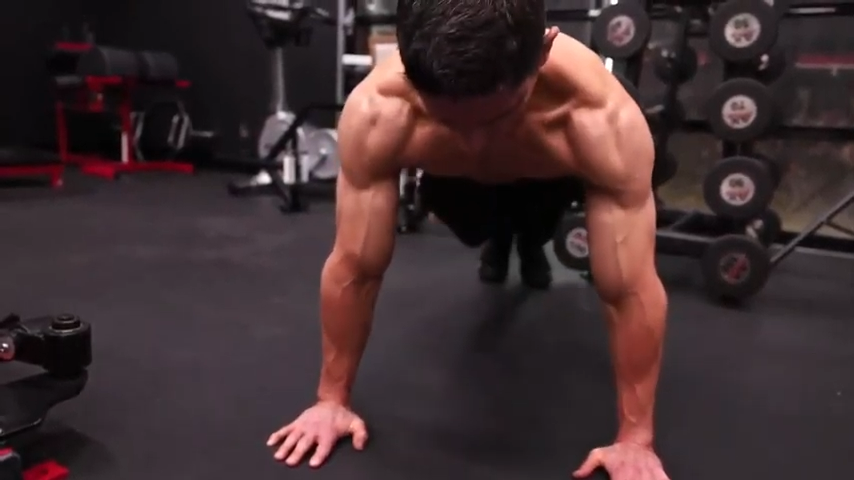
The idea with this bodyweight exercise is to simply go into the top of a Push Up, but then you push all the way through as hard as you can, allowing your shoulder blades to wrap around your body into protraction.
This is going to train the serratus muscles and give them some stability that they oftentimes don’t get unless you intentionally try to train for it.
You’re going to go three sets to muscle failure here. I’m not so concerned about what that number is, as much as I’m concerned that you’re nailing proper form and a stable core on this every single time. A common mistake people make with pushups is trying to do lots of reps regardless of form. This is a waste of time, so focus hard on that good form to get the most out of these.
And then you have it: the Perfect Push Workout.
Guys, remember, it’s not just the exercises you pick, but why you’re doing what you’re doing that gets you the results.
If you’re looking for a weight training program that will help you build muscle and incorporates all the best splits and techniques, you’ve come to the right place. See which of our ATHLEAN-X programs best fit your needs! Whether you’re at the beginner stage of your fitness journey, or you’re at intermediate or advanced fitness levels, we’ve got a program that fits your fitness goals.

- The Perfect Push Workout is a component of a Push, Pull, Legs Workout split routine which is one of the most common training program splits as it creates increases in muscle mass and strength gain.
- A PPL split is a Pull, Push, and Legs training plan that can be performed six days in a row, repeating the three-day split followed by a rest day.
- The other way to perform a PPL split is take a rest day after the first three workouts. After that rest day, you would perform another three days and then rest once again. This asynchronous split causes unpredictable rest days, but allows for more muscle recovery time which leads to overall better muscle gains.
- This Push Day Workout routine is focused on starting off with heavier compound movements and upper body push exercises, then moving to higher-rep exercises that target the chest, shoulders, and tricep muscles.
- You’ll finish each Push Workout with a corrective exercise.
- Utilizing both of these training routines will serve as your Push Workout in the PPL Workout split. Alternate these two training routines whenever the Push Day of the PPL split shows up on the calendar.
- Remember to select weight that will allow for failure in the prescribed rep ranges, aiming to add more weight each time the workout appears.
- Above all, if you train hard, you better be just as dedicated to your recovery. Sleep for no less than 7 hours each night, eat protein-focused whole foods, and take the rest day we discussed.
PUSH DAY WORKOUT FAQ
A push day workout is one of the training days in a Push Pull Legs (PPL) workout split. On push day, you will be training pushing muscles which include chest, shoulders, and triceps.
The 5 best exercises include compound push exercises as well as supporting exercises:
A push pull workout, better know as a Push Pull Legs (PPL) split is the most effective workout split for mass and for building stronger muscles. It's level of effectiveness will depend upon exercise selection, how many days per week you're training, and your adherence to proper form in the classic exercises.
Abs don’t fall into push or pull workouts. You could choose to train abs on the ‘legs’ training session of a Push Pull Legs (PPL) workout split. However, it’s actually ok to train abs 5-6 times a week since they are a muscle group that’s used in almost all of our activities of daily living. Therefore, you could do a short abs workout on each of your training days.
Squats are neither push or pull, but would fall into the ‘legs’ training session of a Push Pull Legs (PPL) workout split.
A push pull workout is better known as a Push Pull Legs Workout Split. This is a type of workout split in which you work pushing muscles on one training day, pulling muscles the next training day and leg muscles on the following training day. Push Pull Legs splits are typically performed 3 days per week or 6 days per week. This type of training split allows for sufficient rest of each set of muscle groups between training sessions.
REFERENCES

Jeff Cavaliere M.S.P.T, CSCS
Jeff Cavaliere is a Physical Therapist, Strength Coach and creator of the ATHLEAN-X Training Programs and ATHLEAN-Rx Supplements. He has a Masters in Physical Therapy (MSPT) and has worked as Head Physical Therapist for the New York Mets, as well as training many elite professional athletes in Major League Baseball, NFL, MMA and professional wrestling. His programs produce “next level” achievements in muscle size, strength and performance for professional athletes and anyone looking to build a muscular athletic physique.
















